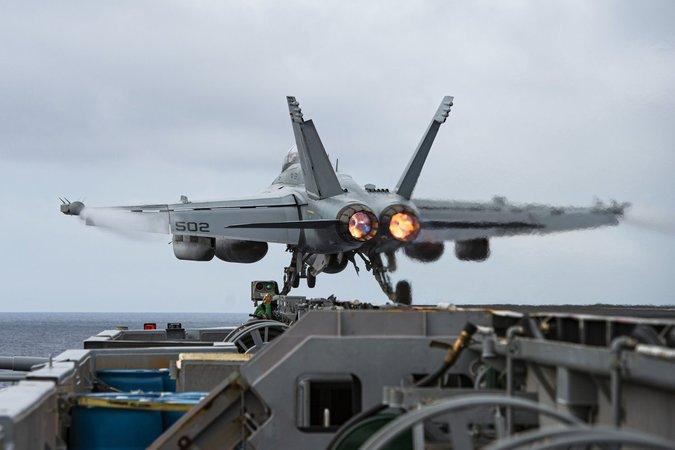Emergency Ejection Saves Navy Pilots in San Diego Coastal Jet Crash
Off the coast of San Diego, a Navy training flight ended abruptly when an F/A-18 Super Hornet experienced a critical failure, forcing its two crew members to eject seconds before the jet plunged into the Pacific Ocean. The pilots’ rapid response and adherence to emergency procedures were instrumental in their survival, with rescue teams from the U.S. Coast Guard and Navy swiftly recovering them from the water. This incident underscores the risks inherent in military aviation training and the importance of rigorous safety protocols.
Incident Overview and Immediate Response
The mishap occurred in the late afternoon under clear skies and calm seas, approximately 10 nautical miles offshore. Radar systems and nearby vessels documented the pilots’ emergency ejection sequence, highlighting the precision and speed of their actions. Both aviators utilized state-of-the-art zero-zero ejection seats, designed to function safely even at zero altitude and airspeed, ensuring their safe separation from the malfunctioning aircraft.
Within 15 minutes, coordinated rescue efforts involving helicopters and surface vessels had successfully retrieved the crew. The rapid deployment of emergency teams prioritized immediate medical evaluation and hypothermia prevention, reflecting the Navy’s commitment to crew safety during high-risk operations.
- Aircraft: F/A-18 Super Hornet
- Crew: Two pilots
- Weather: Clear conditions, calm seas
- Rescue Time: 15 minutes from ejection to recovery
| Parameter | Details |
|---|---|
| Location | 10 nautical miles off San Diego coast |
| Weather Conditions | Clear skies, calm sea state |
| Emergency Response Time | 15 minutes |
| Investigation Status | Active Navy safety board inquiry |
Step-by-Step Breakdown of Ejection and Rescue Operations
As the jet began to exhibit severe mechanical issues, the pilots initiated emergency ejection protocols without hesitation. The tandem-seat configuration allowed the crew to eject in quick succession, bypassing non-essential safety checks to expedite their escape. Their zero-zero ejection seats deployed parachutes flawlessly, enabling a controlled descent into the ocean.
Rescue teams were immediately dispatched, including an MH-60 Seahawk helicopter that maintained visual contact and provided aerial support. Surface vessels arrived promptly to recover the pilots, who were equipped with automatic life vests and emergency locator beacons, facilitating their swift location and extraction.
| Time (Minutes) | Action | Result |
|---|---|---|
| 0 | Ejection initiated | Pilots clear aircraft |
| 2 | Parachutes deployed | Safe water landing |
| 4 | Rescue boats dispatched | Approach pilots |
| 6 | Pilots recovered | Medical assessment underway |
| 10 | Transport to medical facility | Stable condition confirmed |
- Survival Equipment: Automatic life vests and emergency beacons ensured rapid detection.
- Helicopter Assistance: MH-60 Seahawk provided continuous aerial support during recovery.
Investigating the Root Causes and Reviewing Safety Measures
Preliminary analysis by Navy engineers is focusing on potential mechanical and electronic failures that may have triggered the emergency. Data from the aircraft’s flight recorder and maintenance history are being scrutinized to identify whether engine component fatigue, avionics malfunctions, or software errors played a role. Environmental factors such as saltwater corrosion are also under consideration, given their impact on sensitive systems.
Simultaneously, the Navy is reassessing its safety protocols to enhance pilot protection and emergency response efficiency. This includes evaluating the ejection system’s responsiveness and updating training regimens to better prepare crews for unexpected failures.
- Engine turbine blade wear due to prolonged operational stress
- Electrical system disruptions affecting flight controls
- Software inconsistencies following recent updates
- Corrosion from marine environment impacting components
| Safety Aspect | Current Status | Proposed Improvements |
|---|---|---|
| Ejection Response Time | Average 2.5 seconds | Target under 2 seconds |
| Communication Systems | Analog-based | Upgrade to integrated digital networks |
| Training Frequency | Biannual drills | Quarterly simulation exercises |
| Post-Ejection Procedures | Standard Navy protocols | Enhanced survival gear and recovery methods |
Strategies to Improve Pilot Safety and Minimize Future Emergencies
Enhancing pilot safety requires a multifaceted approach that integrates advanced technology, rigorous training, and procedural refinement. Implementing real-time diagnostic systems aboard aircraft can alert pilots instantly to mechanical or avionics issues, enabling proactive responses before emergencies escalate. Additionally, increasing the frequency and realism of simulation drills sharpens pilots’ decision-making skills under pressure.
Other recommended measures include:
- Comprehensive Maintenance Checks: More frequent and detailed inspections to detect potential faults early.
- Biometric Monitoring: Use of wearable sensors to track pilot fatigue and stress levels in real time.
- Enhanced Communication Protocols: Streamlined cockpit-to-ground communication for faster emergency coordination.
- Cross-Industry Training: Incorporating best practices from commercial aviation to broaden safety expertise.
| Strategy | Primary Benefit |
|---|---|
| Real-Time Diagnostics | Immediate detection of system anomalies |
| Simulation Drills | Improved emergency preparedness |
| Health Monitoring | Early identification of pilot fatigue |
| Communication Upgrades | Faster and clearer crisis response |
Summary
The successful emergency ejection and rescue of the Navy pilots off San Diego’s coast demonstrate the critical importance of well-practiced safety protocols and advanced survival equipment. As investigations continue to uncover the causes behind the jet’s failure, the Navy remains committed to refining its procedures and technologies to safeguard aviators during training and operational missions. Further updates will be shared as new information emerges.







